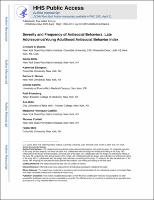Please use this identifier to cite or link to this item:
https://hdl.handle.net/20.500.12202/9645Full metadata record
| DC Field | Value | Language |
|---|---|---|
| dc.contributor.author | Duarte, Cristiane S. | |
| dc.contributor.author | Klotz, Jaimie | |
| dc.contributor.author | Elkington, Kather | |
| dc.contributor.author | Shrout, Patrick E. | |
| dc.contributor.author | Canino, Glorisa | |
| dc.contributor.author | Eisenberg, Ruth | |
| dc.contributor.author | Ortin, Ana | |
| dc.contributor.author | Henriquez-Castillo, Marjorine | |
| dc.contributor.author | Corbeil, Thomas | |
| dc.contributor.author | Bird, Hector | |
| dc.date.accessioned | 2023-12-13T21:10:43Z | |
| dc.date.available | 2023-12-13T21:10:43Z | |
| dc.date.issued | 2020 | |
| dc.identifier.citation | Duarte, C. S., Klotz, J., Elkington, K., Shrout, P. E., Canino, G., Eisenberg, R., Ortin, A., Henriquez-Castillo, M., Corbeil, T., & Bird, H. (2020). Severity and frequency of antisocial behaviors: Late adolescence/young adulthood antisocial behavior index. Journal of Child and Family Studies, 29(4), 1200–1211. https://doi.org/10.1007/s10826-019-01661-9 | en_US |
| dc.identifier.issn | 1062-1024 1573-2843 | |
| dc.identifier.uri | https://hdl.handle.net/20.500.12202/9645 | |
| dc.description | Scholarly article / Open access | en_US |
| dc.description.abstract | _Objectives: An Antisocial Behavior index (ASB-I) for children (ages 5 to 15) was previously developed by obtaining clinician ratings of the seriousness or severity of various behaviors with the goal of improving assessment of antisocial behaviors (ASB) longitudinally. We extend the instrument for use in late adolescence/young adulthood, as socially unacceptable conduct manifests differently across developmental stages. As in the original study, this extension (the ASB-I YA) is based on independent ratings of ASB seriousness/severity during late adolescence/young adulthood (16 to 28 years) made by nine experienced clinicians. _Methods: The items rated were drawn from the Oppositional Defiant Disorder and Conduct Disorder schedules of the NIMH Diagnostic Interview Schedule for Children (DISC-IV) and the Elliott Delinquency scales, plus new or modified items developmentally appropriate for late adolescence/young adulthood. Specific ratings were based on the developmental stage and reported frequency of the behaviors. The study also describes the distribution of ASB-I YA scores in the Boricua Youth Study. _Results: Reliability was substantial for the average ratings of each subscale and for the total score [ICC(3,9): 0.88 to 0.95]. Certain items were rated as more severe when occurring in late adolescence/young adulthood compared to childhood/early adolescence (e.g., hitting someone on purpose); however, most ratings were similar across developmental periods. Most importantly, raters reliably and consistently rated the items describing ASB in young adulthood, allowing the computation of the ASB-I YA score 8. _Conclusions: Together with the ASB-I, the ASB-I YA can further advance the study of ASB progression from childhood into young adulthood. | en_US |
| dc.description.sponsorship | Acknowledgment The authors would like to thank Dr. Terrie Moffitt for providing antisocial behavior items developmentally specific to the young adulthood period to be used in the Boricua Youth Study. The authors are also thankful to all Boricua Youth Study participants, study staff and the clinicians who so graciously donated their time and expertise. Funding: The study is supported by the National Institutes of Health (grant number MH098374). Funding: The Boricua Youth Study was funded by the National Institute of Health [MH56401 (Bird), DA033172 (Duarte), AA020191 (Duarte), MH098374 (Alegria, Canino, Duarte)]. | en_US |
| dc.language.iso | en_US | en_US |
| dc.publisher | Springer US | en_US |
| dc.relation.ispartofseries | Journal of Child and Family Studies;29(4) | |
| dc.rights | Attribution-NonCommercial-NoDerivs 3.0 United States | * |
| dc.rights.uri | http://creativecommons.org/licenses/by-nc-nd/3.0/us/ | * |
| dc.subject | Developmental psychopathology | en_US |
| dc.subject | Antisocial behaviors | en_US |
| dc.subject | Classification | en_US |
| dc.subject | Psychometrics | en_US |
| dc.subject | Longitudinal measures | en_US |
| dc.subject | Young adulthood | en_US |
| dc.title | Severity and frequency of antisocial behaviors: Late adolescence/young adulthood antisocial behavior index | en_US |
| dc.type | Article | en_US |
| dc.identifier.doi | https://doi.org/10.1007/s10826-019-01661-9 | en_US |
| dc.contributor.orcid | 0000-0003-0825-6003 | en_US |
| local.yu.facultypage | https://www.einsteinmed.edu/faculty/17519/ana-ortin-peralta/ | en_US |
| Appears in Collections: | Ferkauf Graduate School of Psychology: Faculty Publications | |
Files in This Item:
| File | Description | Size | Format | |
|---|---|---|---|---|
| Ortin OA 2020 Severity nihms-1544952.pdf | 219.78 kB | Adobe PDF |  View/Open |
This item is licensed under a Creative Commons License

